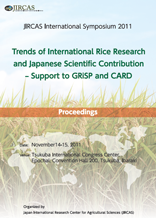Lowland Rice Environment and Potential in West Africa

The lowland rice environment in West Africa is extremely complex. The potential for production of
lowland rice is much higher than that for upland ecologies, presenting the possibility of cultivating two or
more crops annually. Lowland rice therefore becomes a more economically valuable crop than upland rice.
Although rice consumption in African countries has increased in recent years, the production rate is
insufficient to meet demand. The volume of imported rice is increasing annually, which is having a
detrimental effect on African countries’ economies. To resolve these issues, rice production yields must be
increased, either by expanding the production area or by improving the yield per unit of area. Realization of
this goal is impeded primarily by the poor agricultural environment and unsophisticated agricultural
technologies prevailing in Africa. Farmers account for 80% of the population in African countries and make
up a larger proportion of those below the poverty line than in Asian countries. Therefore it is difficult for rice
farmers to acquire adequate equipment and materials to produce rice rationally using best practices.
In lowland ecologies, rice plants often confront shortages and excesses of water, iron toxicity, weeds,
diseases, and insects. The irrigated area is 20% of the total area of rice cultivation in West Africa. Most rice is
planted in rainfed regions (Balasubramanian et al. 2007). Therefore, rice cultivation in West Africa is
influenced strongly by precipitation or overflow from rivers. Upland rice is severely influenced by rainfall
because of the lack of standing water. Yields of upland rice are very low (around 1 t ha-1) compared with those
of lowland rice cultivation (around 2 t ha-1) (Norman and Otoo 2003). Rainfed lowlands therefore offer greater
potential for raising rice production, and represent about 20?50 million hectares depending on the definition
used. At present, only about 10?20% of this area is under cultivation (Africa Rice Center 2004), thereby
offering great potential for rice farming expansion in lowland ecologies. Rainfed lowlands are of various types
according to topographic characteristics such as coastal areas, river lines, and inland valleys in West Africa.
Rainfed lowland, deepwater, and mangrove swamp ecosystems occupy over 33% of the rice cultivation area
from Senegal to Sierra Leone in the Guinea gulf and Nigeria (Balasubramanian 2007). Deepwater ecosystems
occupy more than 50% of rice-cultivated areas in Mali, Niger, and Chad.
A major limiting factor in rainfed lowlands is water control. Rainfed lowlands are classified as
drought-prone, drought and submergence-prone, or submergence-prone areas. Drought-prone areas are
constrained by a short rainy season. To adapt to such environments, rice cultivars must have short growth
duration. Drought and submergence-prone ricelands are often affected by drought. However, rice cultivation
areas are inundated by flooding water by heavy seasonal rains. To adapt to such an environment,
drought-tolerance and submergence-tolerance are necessary. Areas prone to submergence by less than 50 cm
are generally suitable for rice production; however rice cultivars must have high photosynthetic capacity for
prolonged submergence. Deepwater rice??floating rice plants which can grow in more than 50 cm of
water??must have shoot or internodal elongation capability.
| Date of issued | |
|---|---|
| Creator | Jun-Ichi Sakagami |
| Subject |
Deepwater Drought Lowland Rainfed Submergence |
| Publisher | Japan International Research Center for Agricultural Sciences |
| Available Online | |
| Issue | 2011 |
| spage | 114 |
| epage | 121 |
| Rights | Japan International Research Center for Agricultural Sciences |
| Language | eng |
